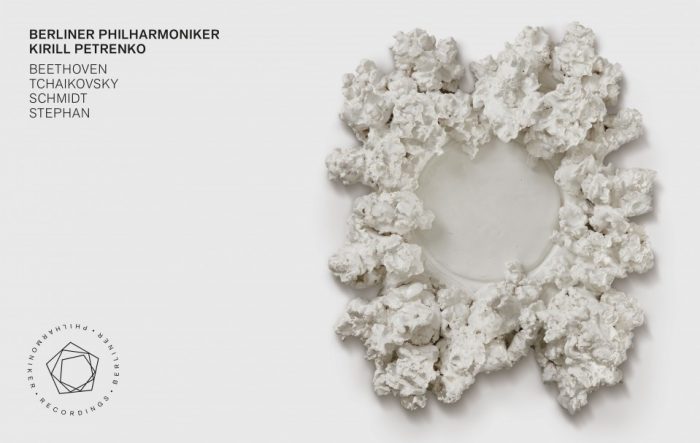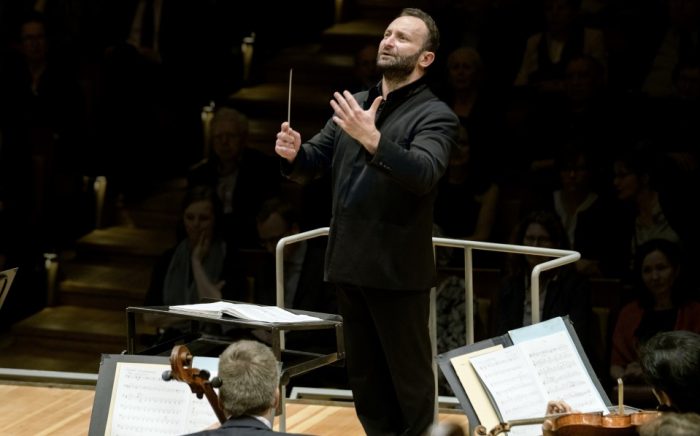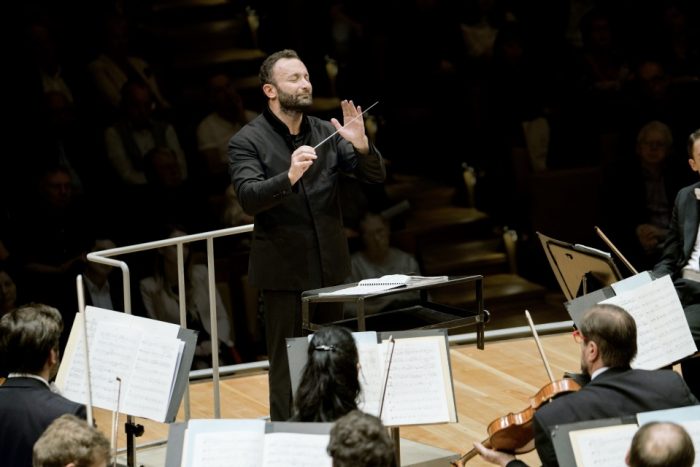 Collectors will no doubt reproach this box set for its inconvenient horizontal format ; others, the dominant matt grey or the very useless works of the visual artist Rosemarie Trockel… Let us rather greet as an event this CD release which retraces the highlights of Kirill Petrenko's presence at the head of the Berliner Philharmoniker. We know the Russian conductor is less interested in communication than his predecessor, which regularly irritates the readers of Wanderer when they discover our reviews of the concerts Petrenko has proposed since 2013 at the Bayerische Staatsoper. Until now, his recordings were mainly forays into little-explored repertoires such as Pfitzner's Palestrina (Frankfurt – Oehms) or the astonishing Asrael Symphony, the culmination of the Josef Suk anthology with the Orchestra of the Komische Oper Berlin (CPO).
Collectors will no doubt reproach this box set for its inconvenient horizontal format ; others, the dominant matt grey or the very useless works of the visual artist Rosemarie Trockel… Let us rather greet as an event this CD release which retraces the highlights of Kirill Petrenko's presence at the head of the Berliner Philharmoniker. We know the Russian conductor is less interested in communication than his predecessor, which regularly irritates the readers of Wanderer when they discover our reviews of the concerts Petrenko has proposed since 2013 at the Bayerische Staatsoper. Until now, his recordings were mainly forays into little-explored repertoires such as Pfitzner's Palestrina (Frankfurt – Oehms) or the astonishing Asrael Symphony, the culmination of the Josef Suk anthology with the Orchestra of the Komische Oper Berlin (CPO).
Kirill Petrenko was officially appointed conductor of the Berlin Philharmonic Orchestra in June 2015, but he officially took up his post in August 2019. This reflects the difficulty born of an interminable Rattle period (2002–2018), followed by a period of division between contenders embodying a return to "tradition" (Thielemann) or a consensus solution (Barenboim). Petrenko's dazzling success in Munich explains to a large extent the growing fame that placed him at the top of the list of candidates for the position of Chefdirigent. Petrenko's success and commitment to the Bayerische Staatsoper also explains the time lapse between the signing of the contract and the actual assumption of the position. Some of his critics considering him a default choice ("he conducted them only twice", "he's not a symphony conductor", "he's a secondary figure"), more reasonable voices observing how carefully he prepared for his arrival in Berlin, a transition conceived as a change of era and horizon which seemed far removed from the options of his more media-friendly predecessor.
Kirill Petrenko has conducted in various opera houses, notably as music director in Meiningen, Berlin and Munich, and as guest conductor he has often conducted in Lyon (for five seasons, invited by Serge Dorny), but also in Frankfurt and Vienna. He used an elliptical sentence to describe the challenge of moving from the orchestra pit to the concert podium and the fact that in opera the responsibility is shared between the different actors who contribute to the artistic result of an evening : "When you conduct a Brahms Symphony, nobody helps you". A symphony being the most radical example of a work exclusively reduced to its musical elements, it is necessary to find, especially in the arrangement of programmes, the dramaturgical urgency which makes a concert the musical equivalent of a theatre of sounds. This feeling of a strong relationship of the works to the initial programmes is sorely lacking here. The boxed set isolates four composers (Beethoven, Tchaikovsky, Schmidt and Stefan) whose symphonies were originally in dialogue with other works, forming ensembles whose coherence deserves to be recalled in order to situate these interpretations in their true context.

Humanity and humanism
This is clearly the case of this eruptive and purposeful Beethoven's 7th Symphony, captured in the Beethoven-Strauss programme that opened the 2018–2019 season. The work followed a first part that included two very dynamic readings of Don Juan and Tod und Verklärung. This programme – Petrenko’s business card, as it were – was the highlight of a tour that took in Lucerne, Salzburg and London. One then discovered the merits of a conductor who carefully reconciled the letter and the spirit, freeing the romantic repertoire from any excessive expressivity in which balance and construction can be lost. The recording of this concert clearly places Beethoven’s 7th in the perspective of a symphonic poem. In the background is the usual virtuosity of dynamic and intoxicating forces. Full of lines and colours, the primary intention does not refer to that "apotheosis of dance" described by Wagner in The Artwork of the Future (1849) – "This symphony is the apotheosis of dance itself : it is dance in its highest essence, the most blessed act of bodily movement, almost ideally concentrated in sound. In his works, Beethoven set the body to music, implementing the fusion of body and mind". Beyond pure choreographic movement, Petrenko strives to emphasize the agôn between rhythms and accents, placing the work in a historical and political context linked to the consequences of the Battle of Leipzig and the birth of the German nation. Premiered a few weeks after this Napoleonic defeat, the Seventh Symphony was performed under the baton of the composer along with another occasional piece of music, Wellington's Victory, for the benefit of coalition soldiers wounded in the fighting. The work closes the revolutionary arc which had started ten years earlier with an Eroica imprudently dedicated to Bonaparte and then to Prince Lobkowitz. The Allegro con brio explicitly rustles with the clatter and clamour of the battlefield, drawing from the obstinacy of the dactyl rhythm a bubbling martiality that contrasts with the fullness of the heavenly spaces of the poco sostenuto. Here the allegretto regains a balance and density rarely achieved – a metaphysical meditation around a falsely funeral march that is already triumphant. The final acceleration plays on an impulse that is more irresistible and liberating than truly spectacular, revealing the return of that threatening low line that closed the first movement.
The Ninth Symphony follows a similar approach and, rather than the overwhelming explosion of a tutelary power, conjures up a feeling of popular revolt, of mankind liberating itself from all bonds. Programmed for Kirill Petrenko's official inauguration on August 23, 2019, it was also part of the celebration of the 250th anniversary of the composer's birth. The work also refers to the history of the Berliner Philharmoniker and pays homage to former conductors, starting with Hans von Bülow, who presented the Ninth twice in a row in the same evening, but also Arthur Nikisch, Wilhelm Furtwängler, and Herbert von Karajan who programmed it for the opening of the new Philharmonic in 1963. As an introduction, Petrenko conducted Alban Berg's Lulu Suite – an astonishing choice that made this inaugural concert a double and symmetrical ode to joy : the painful beauty of the prostitute singing of her wound life which will not last, and the tumultuous and popular joy of this "multitude" finally reunited.
One enters the dark waters of the allegro ma non troppo, carried by a feeling of irremediableness that deserves to be replaced in the funereal and desolate colour of Berg's opera. With the irruption of D minor, the music suddenly acquires a kind of plastic urgency, which is never massive but incredibly dynamic and accentuated. The fortissimos hammered in unison suggest an extraordinarily chiseled structure and balance – a preamble to the irruption of the molto vivace which here does not turn into the timpanist's usual demonstration in the fugato. The strings deliver an alternate tension and expiration that pushes the movement forward, in the form of a burst and impulse whose shadow holds the adagio molto e cantabile in a clear line that flies towards the horizon without procrastination or sharpness. Here the singing is reduced to its expression of pure breath, an admirable demonstration of what an orchestra like Berlin does best when it comes to changing sound into painting – dedicating itself to a musical expression that is not to be reduced to effects in order to better preserve the effectiveness of the dissonant outburst of the presto, with these double basses and cellos that espouse the contours of the singing voice. There is nothing here that lingers or weighs in a legato that refuses the pitfall of narcissism and aims only at the emotion of a musical thought in its purest expression. Kwangchul Youn seems to have borrowed the costume of Gurnemanz when he interrupts these outpourings with a falsely paternalistic “O Freunde, nicht diese Töne!”. Benjamin Bruns is ideally projected, on a par with Elisabeth Kulman who is both robust and authoritaritative. Named artist in residence during the 2019–20 season, Marlis Petersen has to pay the price of her recent Salome in Munich, and even the ambitious Lulu Suite dangerously taxed her strength in the first part. The precaution she takes when she negotiates some changes of register make us prefer the open-air performance given the next day in front of the Brandenburg Gate. On both evenings, the Rundfunkchor Berlin manages to raise the performance to stratospheric heights. The brio and fire of the final volleys, those joyous and raging outbursts which invite the heavens to join in a literally Promethean feast, bear witness to this. Whether in this Ninth or in the Seventh that preceded it, Petrenko rolls out forces whose means and intentions he perfectly understands. This Beethoven is obviously not for all ears, since it paints an uncompromising picture of the Bonn master as the archangel of a Humanity divided between destructive aggressiveness and beneficial ataraxy.

The force of destiny ?
By their withdrawal into a private sphere and their submission to fate, Tchaikovsky's late symphonies form a powerful and complementary antithesis to Beethoven's desire to embrace mankind. We must begin the discovery of Kirill Petrenko's Tchaikovsky with this fabulous Pathétique, which was chronologically inscribed in the first concert following his nomination in 2017. On the programme that evening, Mozart's Symphony No 35 "Haffner" and John Adams' amazing Wound-Dresser for baritone and orchestra. Written after Walt Whitman's eponymous cycle, The Wound-Dresser recounts Whitman's shattering experience as a nurse during the Civil War – the diary of an intimate voice that resonates directly with Tchaikovsky's moods during the composition of his final masterpiece. This performance seems to resort to the same scalpel as used by Whitman to describe the battered bodies of the soldiers with ultra-realistic precision. Tchaikovsky’s wounds and suffering have probably never been rendered to such a degree of enunciation and destitution – far removed from any sentimentality and without the sugary envelope that too often distorts its expression. The Russian conductor is here in a world that he has always known ; he knows that much is expected of him, by those same people who compare his Beethoven with the great discographic references. The exercise seems all the more vain and useless as it risks taking the listener far from the essential : whatever the merits of versions conducted by Mravinsky, Karajan, Abbado, etc., what is important is not whether Petrenko is above or below them, but rather that he is one of the very few conductors who could draw from this score the effusions of brilliance and the degrees of precision which penetrate the musical material at its deepest level.
The adagio offers a sharpness of rhythm and nuances that signal an attention of every instant, from Daniele Damiano’s solo bassoon, both dense and slender, which gives balance to a superlative group of wind instruments. The explosion of the allegro vivo has something organic in the impulse-reaction relationship that bursts into ostinato waves of strings, which can be heard down to the slightest modulation, despite the triple forte. The allegro con grazia refuses the emollient vapours that so often distort its contours. The lively gesture does not give in to the temptation of this false 5/4 waltz, preferring a balance between the various sections that makes bittersweet backgrounds audible – an ideal contrast to the curves and virtuoso élan of the Allegro molto vivace, caught between a shower of staccato notes and a voluntary impulse. We breathe at last in this lamentoso adagio where Petrenko perfectly squares the circle between feeling and expression. Where so many conductors get bogged down in an elegiac vibrato and curtains of tears, the sheer power of the intensity of the sound mass or the enhancement of the volumes and timbres is enough to express the dereliction and resignation of the soul – without any affectation or sentimentality, as we can see in the filmed version, undoubtedly one of the most moving moments of this box set.
Two years later, crowning an eclectic programme that included Schoenberg's Violin Concerto with Patricia Kopatchinskaja, as well as chamber pieces by Milhaud and Ravel, Tchaikovsky's Fifth Symphony is a landmark in the way Petrenko manages to get the best out of the Berliner Philharmoniker, using a palette of relatively simple means and effects. In contrast to his symphonic poems, built around literary sources, Tchaikovsky reduces his last three symphonies to a meditation on the theme of the struggle against destiny and the implacability of the fate to which he felt himself subjected. The resulting obsession here does not have the gleaming brilliance of the brass bands that run through his Fourth. In the penumbra that serves as the setting for this interpretation, one must be able to grasp the extreme concentration that moves the muffled softness of the two clarinets introducing the andante and unfolding the whole arc of expression to the hammered crests of the allegro con anima. In the same way, one must listen to the density of the short and mysterious introduction preceding the entry of the solo horn into the andante cantabile, con alcuna licenza. On Petrenko’s request, Johannes Dengler, the horn player of the Bayerische Staatsorchester, walks here in the footsteps of the illustrious Stefan Dohr, illuminating the dreamlike and intimate lines. Rather than the natural elegance of the waltz, one prefers the gradual ascent of the Finale towards a maestoso which turns into explosive tension and transforms the tempi into nitroglycerine. A passionate reader of Nicomachean Ethics, Petrenko applies the principle of virtue as a golden mean. The final affirmation of the invincibility of destiny is caught between fatality and vital principle – an exact reflection of Aristotle's ideal of perfection : "a work where it is impossible to take anything away or add anything to it, meaning that excess or defect destroys perfection, while the medium ((=the perfect balance)) preserves it"..((Aristotle, Nicomachean Ethics, II,6 : ὅθεν εἰώθασιν ἐπιλέγειν τοῖς εὖ ἔχουσιν ἔργοις ὅτι οὔτ᾿ ἀφελεῖν ἔστιν οὔτε προσθεῖναι, ὡς τῆς μὲν ὑπερβολῆς καὶ τῆς ἐλλείψεως φθειρούσης τὸ εὖ, τῆς δὲ μεσότητος σῳζούσης, οἱ δ᾿ ἀγαθοὶ τεχνῖται, ὡς λέγομεν, πρὸς τοῦτο βλέποντες ἐργάζονται/ hence our habit of saying, when speaking of successful works, that it is impossible to remove or add anything to them, meaning that excess and defect destroys perfection, while the medium preserves it. If, then, good artists, as we call them, have their eyes fixed on this medium when they work, and if, moreover, virtue, like nature, surpasses in accuracy and value any other art, then this is the means towards which it should tend.))

Terra incognita
The box set closes with a Franz Schmidt/Rudi Stephan coupling which forms a musical continent quite distinct from the other two blocks. We know very little about Franz Schmidt in our Latin latitudes. His Fourth Symphony, along with the apocalyptic oratorio Das Buch mit sieben Siegeln (The Book of the Seven Seals), is one of the forgotten masterpieces of an inter-war period trying to recover from a post-Romanticism fighting against the upheavals of the Second Viennese School. A cellist by training, Schmidt was a member of the Vienna Philharmonic Orchestra and played under the direction of Gustav Mahler. An outstanding pedagogue, he played an important role in the cultural life of Vienna in the 1920s. However, it is hard to imagine a composer halfway between Max Reger and Anton Bruckner performing the piano part of Schoenberg's Pierrot lunaire in 1929… The same kind of curious link unites this Fourth Symphony to another masterpiece : Alban Berg's violin concerto "In Memory of an Angel", written in 1935 in homage to the death of Manon, the daughter of Walter Gropius and Alma Mahler. An open string arpeggio opened the solo part, curiously related to the trumpet solo that introduces Franz Schmidt's Fourth Symphony – written one year before Berg’s concerto, and dedicated to his own daughter, who had died in childbirth two years earlier.
Programmed as the second part of a concert that included a brilliant Peri by Paul Dukas and Prokofiev's invigorating Third Piano Concerto ((https://wanderer.legalsphere.ch/2018/05/un-concert-ou-explosent-les-couleurs/)), this Schmidt symphony belongs to those works from the Mitteleuropa repertoire that Kirill Petrenko now aims to defend. Discovered upon his arrival in Vienna in the mid-1990s, this score corresponds for Petrenko to an alternative to Mahler's music, which Franz Schmidt knew for having played it but which he found of no interest as a composer. Built on a single movement, this symphony takes on the personal aspect that can be found in Tchaikovsky's last symphonies. A farewell to the world and a symphonic requiem, the Fourth Symphony remains attached to a tonal style that is both earthy and oppressive. The chromaticism and diminished fourth chords are asserted with unwavering faith, repeated over and over in a melodic continuum that struggles to make its way through this thick curtain of mists and melismas. In the middle of this greyness, a funeral melody develops on a cello solo (here executed by Ludwig Quandt), with remarkable sobriety and restraint. At the end of the four movements, the trumpet solo returns one last time, closing the piece like a palindrome of almost confusing simplicity.

The recording of Rudi Stephan's very soberly named Music for Orchestra comes from a December 2012 concert, which featured another of his scores (Music for Violin and Orchestra), as well as Stravinsky's Symphony of Psalms and a dazzling Poem of Ecstasy by Scriabin, which gave a glimpse of the beautiful future that Kirill Petrenko could offer this orchestra. Tragically deceased at the age of 28 on the Eastern front in 1915, Rudi Stephan distinguished himself at a very young age by an interest in orchestral sounds, by imagining the prototype of a "colour piano" which also evoking Scriabin’s "perfume (and colour) organ" – the Russian composer being one of those which Stephan contributed to make familiar by conducting several of their works, as he did for Schoenberg, Debussy or Stravinsky. The ostensibly neutral title of "Music for…" conceals a writing of remarkable originality and complexity. This music of absolute sound turns away from formal obsession, sometimes reminiscent of the torments and energy of Albéric Magnard's way of bringing together relatively heterogeneous thematic ideas to derive a melodic material of great substance. The passage from a violin solo to a fugato theme, or the combinations of orchestral timbres as disparate as the muffled sound of a tam-tam on trombone outfits, irresistibly bring to mind the modernity one finds in Bartók or Janáček, playing with a sound grammar that is both expressionistic and kaleidoscopic. To conclude this anthology with an absolutely unknown work is surprising.
Careful listening reveals a score that admirably highlights the principles that are at the very basis of Kirill Petrenko's conducting art. Eschewing what Adorno had already perceived when he spoke of "cult" – the heroic figure deliberately cultivated by some conductors to conceal an essentially non-musical or non-instrumental function, an adept of the Hegelian dialectic of the "master and servant" of music, Petrenko appropriates this asymmetrical relationship that links him to the instrumentalists, giving pride of place to fidelity to the score. Obviously disappointing for an ear subject to the diktat of "versions", this art of conducting goes far beyond a listening that would transform music lovers into entomologists pinning down their most beautiful specimens. We are confronted with a reading that tailors the means to the measure of an ambition and an intelligence that perceives music as a total art form, at the crossroads of social sciences, historical and philosophical knowledge. Here approached as a total social fact, music takes on an importance and an authority that places humanity as a vanishing point – this is much better than a performance, it is a lesson.
